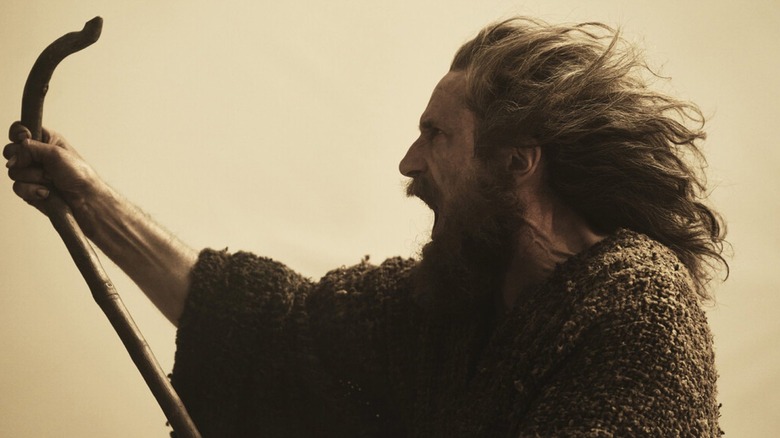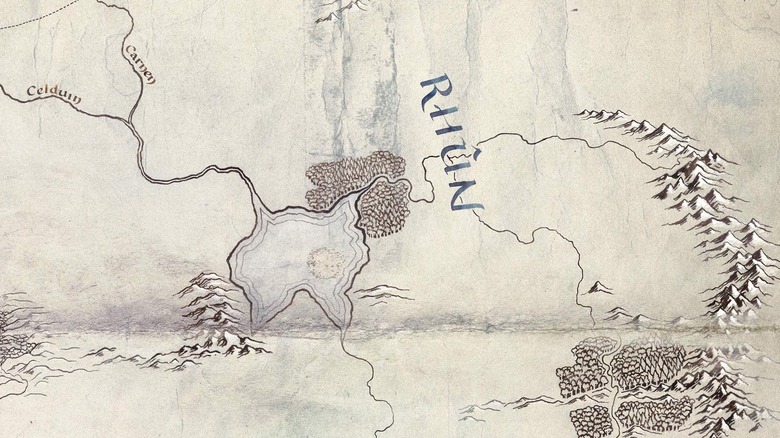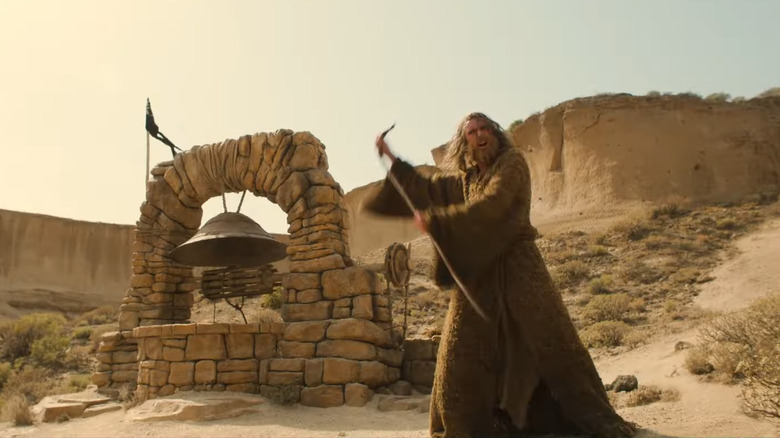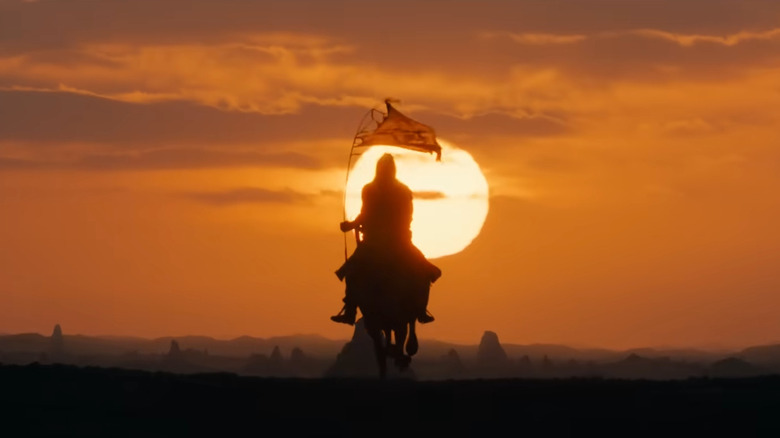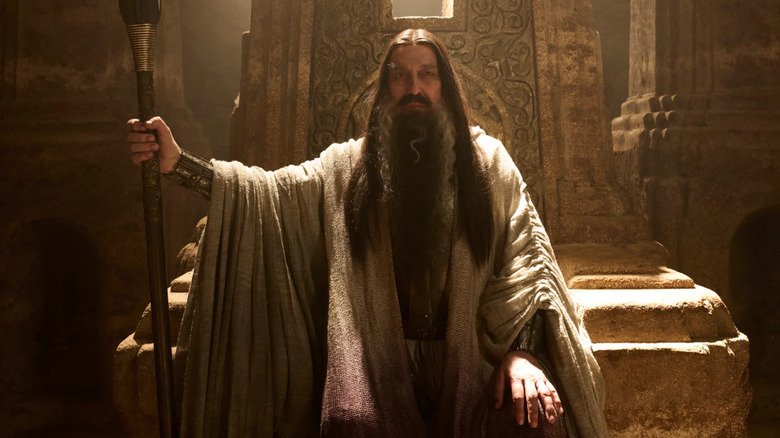The Rings Of Power: What Does Tolkien Say About Rhûn?
"The Lord of the Rings: The Rings of Power" Season 2, the second installment of showrunners J.D. Payne and Patrick McKay's Middle-earth epic, is full of a lot of, well, dust, rock, and sand. Yes, we're talking about the region of Rhûn. The first few episodes manage to rein in the overwhelming number of plot lines from Season 1, but one narrative that picks up steam then is the story of The Stranger (Daniel Weyman) and the Harfoots Nori and Poppy (Markella Kavenagh and Megan Richards, respectively). Over the first portion of the season, the trio finds themselves pushing further and further into Rhûn, where they find marauders, magical staffs, and a severe lack of water.
If you're wondering how much of this is accurate to J.R.R. Tolkien's writings, the answer is that the Oxford author actually didn't write much about the area. Rhûn isn't in "The Lord of the Rings" (although some of its inhabitants are — more on that in a minute), and despite covering a major portion of the continent and being stuffed full of nations of mortal humans and even some distant Dwarven enclaves, Tolkien barely tells us anything about Rhûn itself.
Still, as with most parts of Middle-earth, there are a few tidbits to go from, and these are clearly guiding the showrunners and writers as they all but invent this portion of the story. Let's see what Tolkien did say about Rhûn and how it matches up with the "Rings of Power" adaptation.
Rhûn is close to the origin of Men and Elves
One of the biggest connections of Rhûn to the rest of J.R.R. Tolkien's stories is that it lies away near the area of the world where first Elves and then Men initially "awaken." These groups take turns migrating westward across the continent. First, the Elves travel toward the Undying Lands in the West. Much later, Men follow in their steps and at a more haphazard pace.
The book "The Peoples of Middle-earth" also notes that many of them spend time living by the Sea of Rhûn (the large body of water in the region), adding that they split up as they went along and "their tongues had already diverged." While many of these Men continue west, and some even found the Kingdom of Númenor, this fractionalization leads to the eastern area of Rhûn remaining filled with Human tribes as well as some more distant Dwarven groups that awaken in the area.
Is Rhûn supposed to be a desert?
The accuracy of the arid approach to Rhûn is a complicated question. For the most part, J.R.R. Tolkien doesn't actually tell us what the place is like. The map in this area is mostly blank. However, in an interview in 1966, the Middle-earth creator did say, "Rhûn is the Elvish word for 'east'. Asia, China, Japan, and all the things which people in the west regard as far away." This broad definition implies that at least some parts of Rhûn could be desert. In "The Hobbit" book, Bilbo also references trying to "walk from here to the East of East and fight the wild Were-worms in the Last Desert."
That said, the Middle-earth map also shows mountains, forests, and the giant Sea of Rhûn in the area. The region also supports countless Human tribes and civilizations, which require agriculture. This isn't conjecture. In "The Hobbit," when Bilbo and the Dwarves escape via barrel, they do so by sneaking past an Elven warden who is drunk on wine from the Rhûnic region of Dorwinion. In addition, in "The Return of the King," the appendices talk about the "wild white kine," which are cows living near the Sea of Rhûn.
The Easterlings live in Rhûn
J.R.R. Tolkien repeatedly refers to "Easterlings" as the tribes of Men living in the East in Rhûn. Compared to the Edain (the Men who wander West and end up largely in Númenor), many of these come under the sway first of Morgoth and then of Sauron. "The Silmarillion" says that early on, these mortals from the East get involved in the wars between Morgoth and the Elves, and some of them play treacherous roles, betraying the Elves and the Edain in battle.
Later in that book, it says that in the Second Age (when the Rings of Power) takes place, "Further east Men multiplied; and most of them turned to evil, for Sauron was at work." The book also says that later in the age, "In the east and south well nigh all Men were under [Sauron's] dominion, and they grew strong in those days and built many towns and walls of stone, and they were numerous and fierce in war and armed with iron." After this, we get the disturbing line, "To them Sauron was both king and god; and they feared him exceedingly, for he surrounded his abode with fire."
The book "The Peoples of Middle-earth" also talks about the situation in Rhûn and the east, saying, "For Sauron had acquired dominion over many savage tribes in the East (of old corrupted by Morgoth), and he now urged them to seek land and booty in the West." This sets the stage for ongoing hostilities between the eastern and western portions of the continent, and Tolkien has Easterlings play the role of a recurring boogeyman to the western portions of Middle-earth for thousands of years. Invasions appear from time to time, and there are many Easterlings who fight in Sauron's armies during "The Lord of the Rings."
There are also Wizards in Rhûn
It makes sense that "The Rings of Power" is sending their Istar (Wizard) east and that another Wizard is out there already. One of the biggest things we actually know about Rhûn is that there are Wizards there. For instance, Saruman spends time out thataway before "The Lord of the Rings" stuff kicks off. More importantly, in J.R.R. Tolkien's texts, Rhûn and the East are where the two Blue Wizards, called Alatar and Pallando spend most of their time.
The books "Unfinished Tales" and "The Peoples of Middle-earth" give us a few scraps of information about the Blues. These travel into the East with Saruman, but only Saruman returns. Earlier in life, Tolkien added that he didn't know much about what happened to the Blue Wizards, but they probably turned evil and led secret cults. Later, he revised the narrative, suggesting that they were important in resisting Sauron in those areas of Middle-earth, but he never developed the story.
In the show, so far, we don't know if the Wizards in Rhûn are Blue Wizards or not. However, the fact that one of them is good and the other is bad aligns with different aspects of Tolkien's writings for both pairings.
While Rhûn barely features in Middle-earth canon, it does have enough pieces of lore for "The Rings of Power" to create a really fun part of its continent-spanning story. Now we just have to wait to see if the show can stick the landing.
